 The EM Site-Specific Advisory Board (EM SSAB) is considered a single advisory board; however, eight local boards are organized under its umbrella charter, one at each major EM cleanup site. The local boards are the Hanford Advisory Board, Idaho Cleanup Project Citizens Advisory Board (CAB), Northern New Mexico CAB, Nevada SSAB, Oak Ridge SSAB, Savannah River Site CAB, Portsmouth SSAB, and Paducah CAB.
EM is working to implement President Biden’s executive order to promote diversity, equity, inclusion, and accessibility in the federal workforce as well as the cleanup program’s federal advisory committees.
The EM Site-Specific Advisory Board (EM SSAB) is an important tool for EM to obtain public input for community-specific solutions. The eight local boards organized under the umbrella charter of the EM SSAB develop recommendations for field managers at eight of EM’s field locations.
Community input is enhanced by a board that closely reflects a diversity of viewpoints from the site’s region. In support of Executive Order 14035, EM is looking to pursue opportunities to increase diversity, equity, inclusion, and accessibility on advisory boards.
 |
|
In addition to the community-focused EM Site-Specific Advisory Board, the Environmental Management Advisory Board provides independent and external advice, information, and recommendations directly to the EM Assistant Secretary on corporate issues related to accelerated site cleanup and risk reduction. |
Extensive site-specific recruitment efforts help populate diverse, community-focused advisory boards. Recruitment efforts include outreach to many local women’s, minority, young professionals, and labor organizations, as well as outreach in local newspapers, community centers, libraries, and colleges. Local board staff are encouraged to get creative with recruitment methods to increase interest, using social media and virtual outreach.
EM’s advisory board team keeps a close eye on the demographic makeup of the boards to promote diversity in many areas, including age, gender, race, education, experience, and geographic location. This diversity enhances creativity and effectiveness of the boards and amplifies voices of the communities surrounding EM sites.
“The increased time spent focusing on diversity ensures community members from underrepresented groups will have a seat on the board,” EM SSAB Designated Federal Officer Kelly Snyder said. “Every voice matters, and we want to ensure all sects of the community have the opportunity to voice their perspectives regarding the important work we do.”
-Contributor: Alyssa Harris
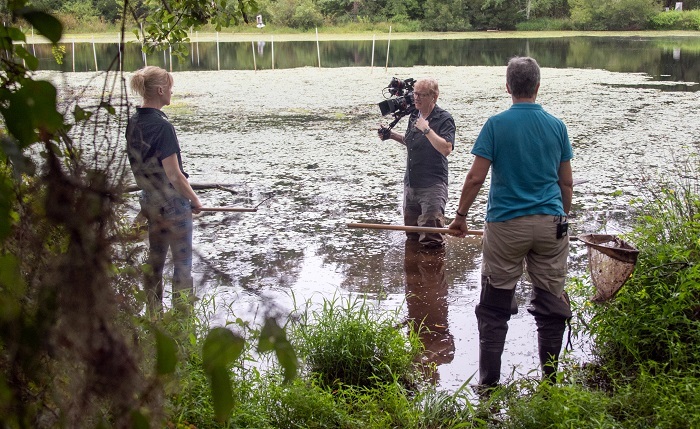 EM contractor Savannah River Nuclear Solutions (SRNS) is creating a series of videos and learning resources for classroom learning in place of traditional field trips to the Savannah River Site. Kimberly Fickling, left, and Beth Eberhard, far right, with the Ruth Patrick Science Education Center at the University of South Carolina Aiken, are shown working on the video “Wet Wonders” with SRNS employee Brad Bohr, center.
AIKEN, S.C. – In just one month alone this year, EM’s cleanup contractor at the Savannah River Site (SRS) provided education outreach to more than 25,000 students and 410 educators.
Savannah River Nuclear Solutions (SRNS) has been sharing its diverse science, technology, engineering, and math (STEM) program with local public and private schools since 2008, when it became the site’s management and operations contractor.
“Elementary school through college, the statistics over the years validate SRNS support for quality education throughout the region,” said Kim Mitchell, with SRNS education outreach programs. “It’s truly an honor to assist and serve these amazing teachers and wonderful students who are the lifeblood of our future.”
To date, SRNS has provided more than $5 million for education outreach, supporting more than 275,000 students and teachers throughout seven counties near SRS.
“We value the transformative community partnerships we have with organizations like Savannah River Nuclear Solutions, and the 12 outreach programs they provide that directly impact our faculty and students,” said King Laurence, Aiken County Public Schools superintendent. “Whether it’s $1,000 mini-grants for teachers or dozens of scientists and engineers visiting our schools, we look forward to years of continued success with SRNS.”
The COVID-19 pandemic prompted SRNS to develop innovative methods and incorporate cutting-edge technology to reach students and educators, creating multiple virtual platforms for that audience.
“We’re confident that virtual reality technology and web-based apps will strongly and positively impact students and teachers,” Mitchell said. “And in time, when we return to business as usual, these tools will continue to reach a much broader group throughout the region than we’ve documented in the past.”
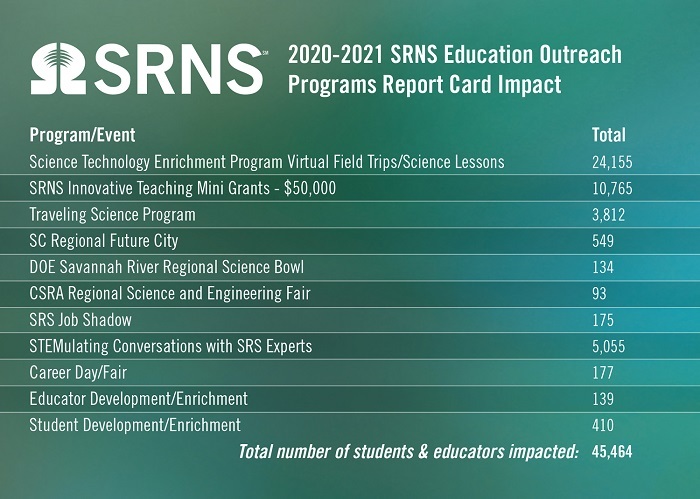 More than 45,000 students and educators were impacted by Savannah River Nuclear Solutions education outreach from 2020 to 2021.
SRS virtual field trips showcase science lessons about the site, targeting students with educational content specific to their grade levels. Some of the field trip lessons help participants determine the health of a pond, or assist endangered species, such as the red-cockaded woodpecker. Students can also explore the inner workings of a mass spectrometer in a site laboratory. That highly sensitive piece of equipment allows laboratory personnel to separate individual components of a substance, resulting in the exact identification of each component and the amount present in the substance being tested.
“Feedback from educators and administrators affirm that the SRNS Education Outreach Program has been highly successful, significantly impacting school systems throughout South Carolina and the greater Augusta, Georgia area,” said Mitchell.
The SRNS STEM-intensive offerings include a traveling science demonstration program, workshops, tours, talks, demonstrations, and other content.
Some programs test the depth of students’ knowledge and experience. They include the South Carolina Regional Science Fair, DOE Savannah River Regional Science Bowl, and the Regional Future City Competition.
SRNS also offers annual mini-grants to area teachers through corporate funding. To date, SRNS has contributed more than $700,000 to support educators in the region.
To reach local adults pursuing higher education degrees, SRNS has signed memorandums of understanding with local technical colleges, historically Black colleges and universities, and other four-year degree institutions such as the University of South Carolina Aiken.
-Contributor: DT Townsend
An artist’s rendition of the K East Reactor safe-storage enclosure. K East will be the seventh of Hanford’s nine former reactors to be placed in interim safe storage while radioactivity in the reactor cores decays over the next several decades, making it easier and safer to dismantle the reactors in the future.
RICHLAND, Wash. – EM Richland Operations Office (RL) contractor Central Plateau Cleanup Company (CPCCo) has awarded two construction subcontracts worth about $9.5 million to Richland-based DGR Grant Construction Inc. to progress critical risk-reduction work along the Columbia River at the Hanford Site.
DGR Grant is tasked with constructing a safe-storage enclosure over the K East Reactor to place the reactor into interim safe storage, including preparing the foundation and installing supporting infrastructure. The enclosure will protect the reactor building while the radioactivity in the reactor core decays over the next several decades, making it easier and safer to complete disposition of the reactor in the future.
“Awarding this contract is a major step toward the completion of work in Hanford’s K Reactor Area,” said Bob Krebs, CPCCo project manager for the safe-storage enclosure. “We look forward to working with the Department of Energy and our cleanup partners to safely execute this critical risk-reduction project.”
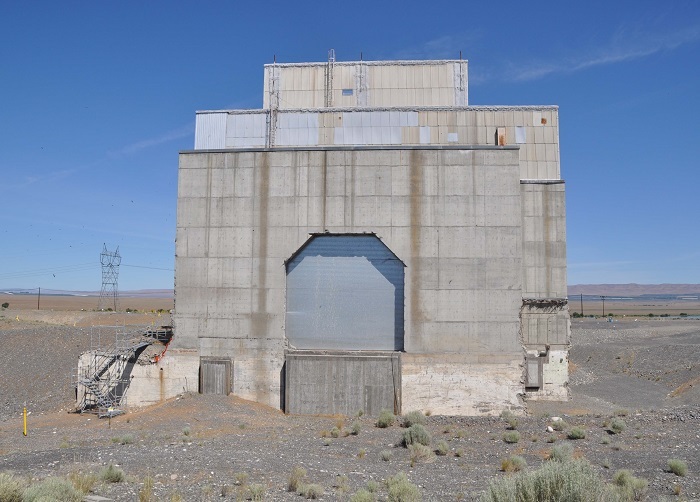 EM Richland Operations Office contractor Central Plateau Cleanup Company recently awarded two subcontracts to DGR Grant Construction Inc., of Richland, Washington to build and install an enclosure over the former K East Reactor building on the Hanford Site.
Groundbreaking on the foundation for the storage enclosure is scheduled to begin in September. Construction of the steel structure is slated for early 2022 with completion expected in 2023.
“Work on placing the K East Reactor in interim safe storage progresses our mission to protect the public and the Columbia River,” said Mark French, RL project and facilities division director.
The K East Reactor operated from 1955 to 1971 and will be the seventh of Hanford’s nine former reactors to be placed in interim safe storage. The K West Reactor will be the eighth. The ninth, the B Reactor, has been preserved as the world’s first full-scale nuclear reactor and is part of the National Park Service’s Manhattan Project National Historical Park.
-Contributor: Dieter Bohrmann
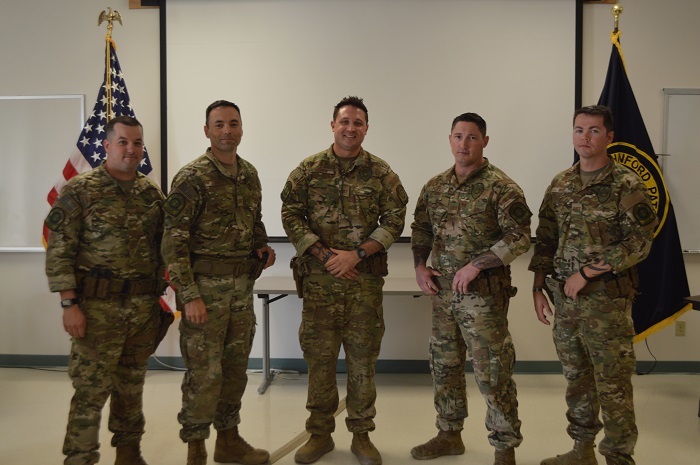 The newest members of Hanford Patrol’s special response team completed 30 days of training that included weapons mastery and superior physical strength.
RICHLAND, Wash. – Following a grueling training and instruction regimen, the Hanford Site graduated five new members of an elite law enforcement squad that protects the site from potential security threats.
EM contractor Hanford Mission Integration Solutions (HMIS) manages the Hanford Patrol and selects only those candidates with the highest level of physical skill and mastery of weapons for the protective force’s special response team.
Classroom and field instruction for Hanford’s special response team consists of five times the required amount typical for a SWAT member in Washington state. Applicants must receive a supervisor recommendation before passing an interview and tryout.
“These five graduates are at the tip of the spear for keeping our materials and our people protected, so that the cleanup mission can occur and the nation’s assets are protected,” said Brian Stickney, deputy manager for the Hanford Site.
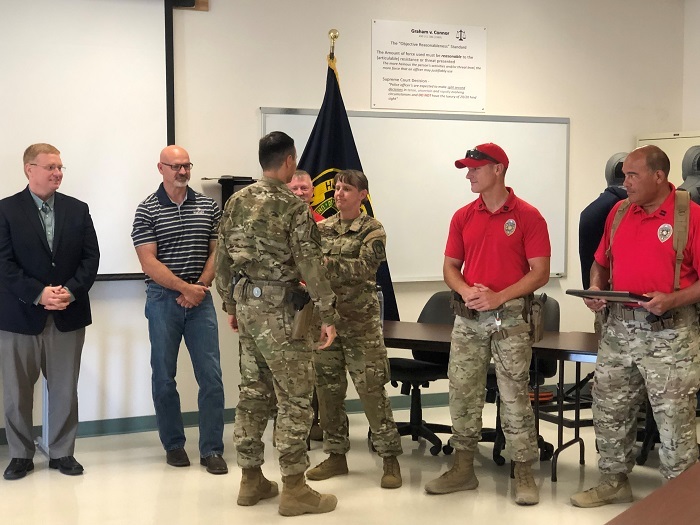 Brian Stickney, left, deputy manager of the Hanford Site, looks on as Hanford Patrol Chief Casey de Groof affixes a patch to one of the newest members of the special response team, which graduated five officers to join the elite team.
As part of the first graduating class in two years, the officers completed rigorous training while wearing 40 pounds of gear and helmets. Instructors adhered to strict government safety measures to protect trainees from the summer heat.
“This team is the sharpest and most potent arrow in your quiver of last resort,” Hanford Patrol Col. Kyle Hiller said. “I would put this team up against any tactical team in the nation.”
Instructors provided the training. They also assisted DOE’s national training certification team as it conducted its three-year recertification of the special response team program.
“The level of training we get here is excellent,” said Robert Pofahl, honor graduate and former Marine Corps sniper. “The instructors do a phenomenal job.”
-Contributor: Robin Wojtanik
|